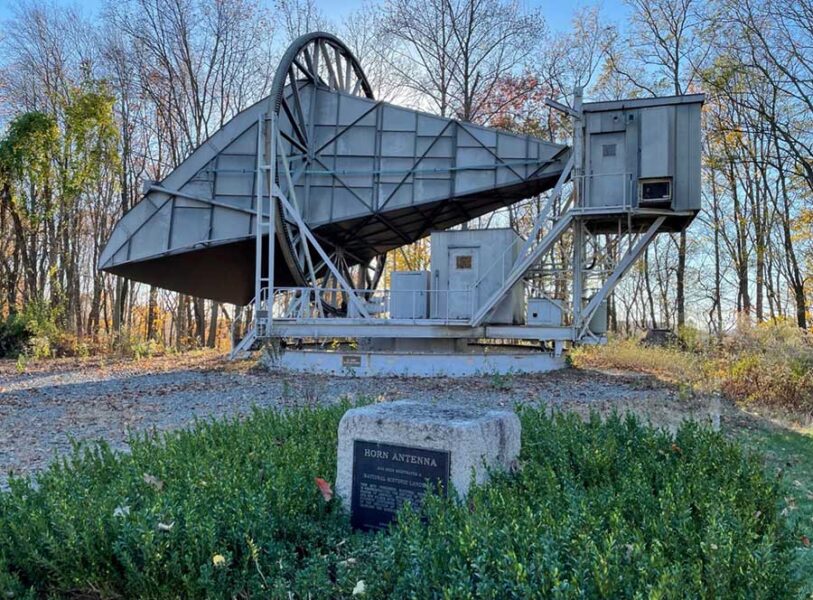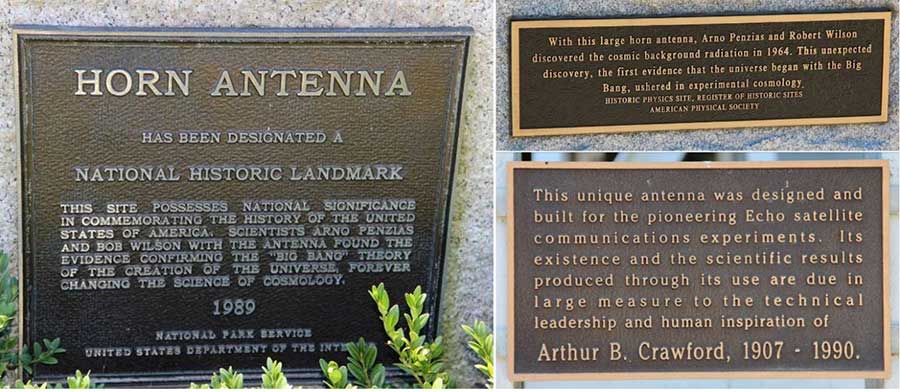While redevelopment plans threatened the Holmdel Horn, the instrument that detected the “hiss” of background radiation from the Big Bang, the township has now instead voted to acquire and preserve the property.
Updates:
On Tuesday, June 13th 2023, the Holmdel Township Committee voted unanimously to acquire two of the three parcels that make up the Crawford Hill property, home to the historically significant horn antenna and the top of the Holmdel watershed. Approving the resolutions is a major step toward preserving Crawford Hill as a public park to celebrate the horn antenna’s place in scientific history and protect our drinking water. Read more here.
The original story is below.
The Holmdel Horn, the microwave antenna that Arno Penzias and Robert Wilson used to detect the cosmic microwave background radiation that provided irrefutable evidence of the Big Bang, is under threat. The antenna was designated a National Historic Landmark in 1988, and the American Physical Society lists it as a “historic physics site.” But new plans to build up the area could see the horn lost.

Lawrence Faltz
Arthur B. Crawford designed the Horn to support Project Echo, a NASA communications program. Echo satellites were inflated mylar spheres 100 feet (30 meters) across that orbited between 600 and 800 miles (1,000 and 1,300 km) above Earth. NASA made these simple passive microwave reflectors for intercontinental telephone, radio, and television transmission. Actively transmitting satellites rapidly made the Echo system obsolete, and the last Echo deorbited in 1968.
The Holmdel antenna itself is 50 feet long, with an opening 20 feet wide. The reflecting surface is parabolic, with incoming radiation coming to a focus at the small end of the horn, which houses a cryogenic receiver. The mount tracks in altitude and azimuth.
During their work with the antenna in the 1950s and 1960s, Penzias and Wilson encountered a persistent hissing noise. Modeling it as thermal emission, they initially estimated a blackbody temperature to be 4.2 kelvin. After meticulously checking the antenna and receiver, and even scrubbing the interior free of pigeon droppings, the noise persisted. They had no idea where it came from until MIT physicist Bernard F. Burke put Penzias and Wilson in touch with Princeton physicist Robert Dicke.
Dicke’s group had been working out whether evidence could be found to support the idea that the universe that began in a tiny, dense, hot state, and has been expanding ever since. In fact, they were about to build their own antenna. When the Princeton and Holmdel groups met, they realized that each had solved the other’s problems.
A pair of short papers appeared in Astrophysical Journal Letters in July 1965 announcing the findings, first Dicke’s theoretical treatment (with coauthors James Peebles, Peter Roll, and David Wilkinson) and then Penzias and Wilson’s observational findings, each paper acknowledging the other. The competing steady state theory, advanced by Hoyle, Gold, and Bondi in 1948, had no satisfactory explanation for the radiation, and faded into irrelevance.

Lawrence Faltz
The antenna is located in Holmdel, New Jersey, just 27 miles as the crow flies from Times Square in Manhattan. The 43-acre site includes a 50,000 square-foot research building, now shuttered, at the base of Crawford Hill, which is the highest point in Monmouth County. At the top of the hill, the Horn is set in a field among a few other derelict structures built for communications research. The views across to Holmdel High School and out to Raritan Bay and Manhattan are dramatic.
The horn itself is intact, if a little weather worn. The property was originally owned by Bell Labs, the research arm of the Bell system until an anti-trust finding broke it up in 1983. Among its many inventions, Bell Labs created the transistor, CCDs, the solar cell, the UNIX operating system, and the C++ programming language. Nine Nobel prizes were awarded for Bell Labs inventions. In 2016, Nokia acquired what remained of Bell Labs after many transformations. The small building on the Crawford Hill site was shuttered, and the road to the top of the hill, where the antenna is located, was fenced off. It is now off-limits to visitors. In 2021, the site was sold to a local technology executive, who may be interested in building high-end residences. Holmdel is one of New Jersey’s most affluent communities.
At a meeting on November 22nd, the Holmdel Township Committee passed a resolution asking the town’s Planning Board to determine if the Crawford Hill Horn Antenna site should be designated “an area in need of redevelopment.” If the town permits development of the site, most likely to build high-density residences, the Horn could be removed or even destroyed. The fact that it is a National Historic Landmark does not protect it. The horn is on private property and receives no Federal funds for its upkeep.
Three local organizations — Citizens for Informed Land Use, Friends of Holmdel Open Space, and Preserve Holmdel — have organized a petition and advocacy campaign that asks the town of Holmdel to not permit development but instead to create a park on Crawford Hill and preserve the Horn.
Larry Faltz is a retired physician and member of Westchester (NY) Amateur Astronomers.
 4
4









Comments
robert stenton
December 9, 2022 at 5:29 pm
Green Bank in West Virginia besides having a number of in use historical radio telescopes including the GBT and having a major well visited visitor center also has Grote Reber's telescope and a model of Karl Jansky's radio telescope. If the not so visited Horn Antenna has to be moved, Green Bank is the place.
You must be logged in to post a comment.
David Kolb
December 10, 2022 at 9:23 am
I have the same sentiment. If the local community decides not to save the Horn Antenna then it should be moved to Green Bank where it can be appreciated by visitors and become part of their educational program.
You must be logged in to post a comment.
Anthony Barreiro
December 10, 2022 at 8:02 pm
The Holmdel Horn Antenna changed humanity's understanding of our place in the universe. The antenna belongs to all of humanity. The owners of the property, Holmdel Township, and Monmouth County have a historic responsibility to preserve the antenna so future generations can see and appreciate it.
You must be logged in to post a comment.
Frank-ReedNavigation.com
December 12, 2022 at 12:17 pm
Anthony, you suggested:
"The antenna belongs to all of humanity."
But does it? Does it really?? We have to pick our battles, and this one? Meh. It's an old microwave antenna. It would be "nice" if someone could haul it, or some significant portions, away to a site like Green Bank (as suggested above by David Kolb) where it could be visited by the public, but at its current location, it's just junk. Few people have the opportunity to visit except by slipping through a locked gate (see reviews on Google Maps). Another relocation option might be the "InfoAge Science and History Museum" which is already closely focused on related radio topics (it's located on "Marconi Road"). That's only 15 miles away from Holmdel.
You noted:
"The owners of the property, Holmdel Township, and Monmouth County have a historic responsibility..."
Monmouth County does have a historic responsibility to astronomy, and it's half a mile away. The location of the "Holmdel Horn" is immediately adjacent to the Garden State Parkway and directly across the highway --half a mile distant-- from one of the biggest sources of light pollution in New Jersey: the "PNC open-air amphitheater", whose shockingly bright lights can surely be seen from Barnard's Star.
You must be logged in to post a comment.
You must be logged in to post a comment.